Ãëàâíàÿ
ñòðàíèöà
Äîêëàäû
Ñâåäåíèÿ îá
àâòîðàõ
Aerobic Landfill Application in Developing Countries: A Case Study
M. Sinan Bilgili, Selin Top, Elif Sekman, Gamze Varank, Ahmet Demir, Yildiz Technical University, Istanbul, Turkey
Abstract
This paper presents the results of an experimental study carried out in field-scale test cells in order to determine the effect of aeration and leachate recirculation on waste decomposition rate, leachate quality and quantity, landfill gas composition, solid waste characteristics and settlement in the landfill body. Four landfill test cells with the dimensions of 20 x 40 x 5 m were constructed in Komurcuoda Sanitary landfill, Istanbul, Turkey. Test cells were operated simulating anaerobic landfilling (AN1), leachate recirculated anaerobic landfilling (AN2), semi-aerobic landfilling (A1) and aerobic landfilling (A2) methods. It is concluded that there will be a significant and rapid improvement in leachate quality and also reduction in leachate treatment costs in aerobic landfill sites. The results of this field-scale study show that many important advantages can be achieved especially in the case of operating unsanitary landfill sites as aerobic or semi-aerobic. In the case of impossibility of aerobic landfilling, it was stated out that application of leachate recirculation could be effective in shortening the stabilization time, providing in situ treatment of leachate and accelerating the landfill gas production.
Key words: solid waste, aerobic landfill, anaerobic landfill, semi-aerobic landfill, leachate recirculation.
1. Introduction
Landfilling allows the organic part of the waste to be decomposed to inert and
stabilized materials under controlled conditions by the activity of aerobic and
anaerobic bacteria. In a conventional landfill, waste degrades via fermentation
processes under anaerobic conditions.
Anaerobic degradation in conventional landfills occurs
as a consequence of a series of metabolic interactions among various groups of
microorganisms. Physical, chemical, and biological processes occur within a conventional
landfill body to promote the anaerobic degradation of solid waste and result
with the production of leachate, landfill gas and biologically stable solids
for a very long time.
Since anaerobic decomposition of solid waste in conventional landfills is a slow process, there has been an increased emphasis on bioreactor landfill technology in recent years in order to increase the waste degradation rate, provide a reduction in landfill emissions in a shorter period of time, and treat leachate in situ. One of the most widely used methods for increasing solid waste degradation in landfills is leachate recirculation.
In addition to leachate recirculation, new research concerning the pretreatment of waste, aeration, and flushing of the waste mass has been proposed for the reduction of landfill emissions. There has been an increasing interest in aerobic and semi-aerobic landfilling operations as a means of improving the quality of leachate and landfill gas during recent years. Aerobic biodegradation is an environmentally sound approach consisting of an accelerated degradation of heterogeneous organic matter by a mixed microbial population in a moist, warm, aerobic environment under controlled conditions. The primary goal of the aerobic landfill system is to achieve optimum in situ waste treatment and volume reduction (and ultimately stabilization) through aerobic degradation. In contrast to anaerobic bioconversion, this reaction is strongly exothermic.
Overall, beyond many advantages of aerobic landfilling technology, this approach is not a cost-effective system. Another alternative in solid waste disposal to increase the stabilization rate and shorten the decomposition time is semi-aerobic landfilling.
The semi-aerobic landfill system can be explained as a system where the leachate and gas are continuously removed from the waste mass using leachate collection and gas venting systems, with proper engineering designs in which the ambient air flows into the waste body naturally through the leachate collection pipes, and subsequently improves the waste stabilization process and increases the leachate quality due to the enhancement of the micro-organisms activities in the waste body.
The aim of the existing research is to investigate the anaerobic, semi-aerobic and aerobic bioreactor landfilling technologies as alternative methods for enhancing solid waste stabilization in landfills comparing with conventional landfilling method. The paper summarizes the results of field-scale solid waste bioreactor landfill cells to quantify the effect of aeration (forced and natural) and leachate recirculation on the rate of biological degradation of the solid waste at Komurcuoda landfill site (an engineered landfill), which is located in Istanbul, Turkey. The dimensions of the test cells constructed were 20 x 40 x 5 m. Alternative landfilling methods for accelerating solid waste stabilization in landfills are investigated by the means of i) leachate quantity and quality, ii) temperature variation in landfill body and iii) landfill settlement.
2. Material Method
2.1. Aerobic and Anaerobic Landfill Test Cells
Four identical field-scale test cells simulating anaerobic (AN1), anaerobic leachate recirculated (AN2), semi-aerobic (A1) and aerobic (A2) landfills were simultaneously operated for a period of about 450 days in order to investigate the effect of alternative landfilling methods used for accelerating the waste decomposition rate and minimizing the long-term environmental impacts. Test cells were constructed with the dimensions of 20 x 40 x 5 m (B x L x H) in Komurcuoda landfill site (41°8'41''N, 29°22'21''E) in Istanbul, Turkey. The average composition of solid wastes landfilled at the test cells was 44% organic (food and yard wastes), 8% paper, 6% glass, 6% metals, 5% plastic, 5% textile, 9% nylon, 8% diaper, and 9% ash and others. A detailed schematic view of the test cells is depicted in Figure 1.
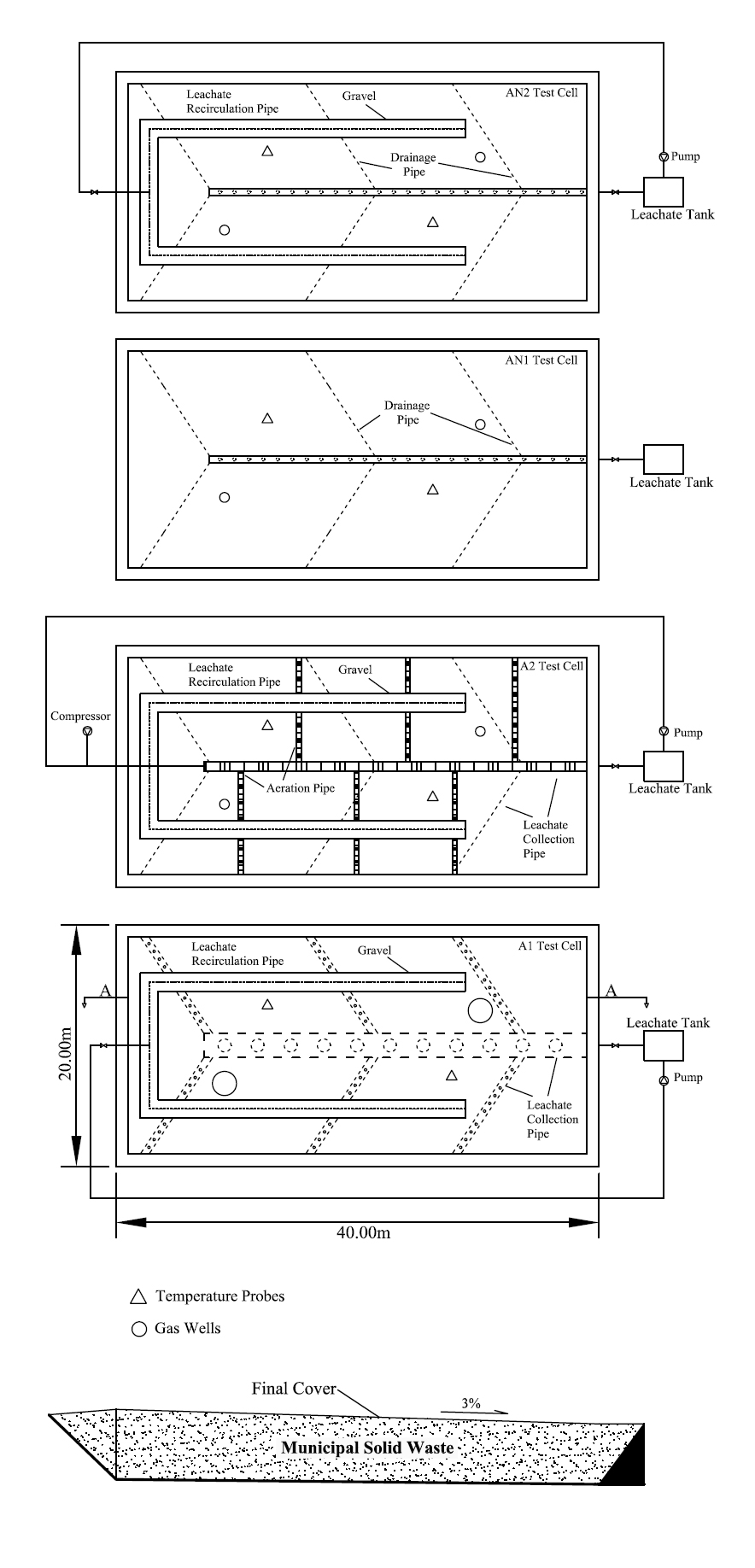
Figure 1. A detailed schematic view of the test cells
The impermeable liner of the test cells was constructed acording to the technical standards explained in the «Regulation for the Landfilling of Wastes» of Ministry of Environment and Forestry. Leachate collection was achieved by perforated pipes (Ø150 mm) in aerobic (A2) and anaerobic (AN1, AN2) test cells. In the semi-aerobic test cell (A1) the leachate collection pipe (Ø500 mm) was also used to provide aeration. In the aerobic test cell (A2) aeration pipes were constructed and forced aeration was provided with a compressor and blower system. The aeration was regulated by measuring CO2, CH4, and O2 content of the landfill gas. To avoid the anaerobic conditions in the landfill body in aerobic reactor, O2 content of the landfill gas was held in the range of 5–15%.
The discharged leachate from the test cells was collected in storage tanks and recirculated to A1, A2 and AN2 test cells. Landfill gas was collected via the perforated pipes, which were located in the center of each cell. Temperature probes were located at four different depths (1.0, 1.5, 2.0, and 3.0 m) in the landfill body to measure temperature variations in each test cell.
The photos of test cell preperation and operational period are given in Figure 2 to Figure 11.

Figure 2. Preperation of landfill liner

Figure 3. Membrane application to the bottom of the test cells

Figure 4. Geotextile application to the bottom of the test cells

Figure 5. Drainage pipes application to the test cells

Figure 6. Gravel application to the test cells

Figure 7. Solid waste disposal to the test cells

Figure 8. Aeration pipes and gas wells

Figure 9. Aeration pipes application to aerobic test cell

Figure 10. Control room for compressor, blower and recirculation pumps

Figure 11. Topographical measurements
2.2. Experimental Study
2.2.1. Leachate analysis
Leachate samples collected from A1, A2, AN1, and AN2 test cells were analyzed to determine chemical oxygen demand (COD), biological oxygen demand (BOD), total Kjeldahl nitrogen (TKN), and ammonia nitrogen (NH3-N), parameters. All analysis were realized according to the relevant methods described in the Standard Methods of APHA.
2.2.2. Topographical measurements
Topographic measurements were performed in order to determine the covered area and estimated boundries of each test cell. In addition, the elevations based on the specific points of each cell have been identified. The same measurements were repeated at the later stages of the study in order to determine the amount of settlement. Volumetric difference between the measurements was defined as the amount of settlement. Measurements were carried out by Nikon DTM-332 total station device and its equipments.
3. Results and Discussion
3.1. Leachate Quantity and Quality
3.1.1. Leachate quantity
Leachate is the most complicated and costly wastewater to treat due to its high organic and inorganic pollutant content. To reduce treatment costs of leachate, it is necessary to control leachate quantity and improve leachate quality. Leachate recirculation is a solution for in situ control and treatment. The variation of leachate quantity in test cells is given in Table 1. As can be seen from Table 1, leachate quantity produced in A1, A2, AN1, and AN2 test cells was determined to be 154, 186, 111 and 141 m3, respectively at the end of the study (440 days). The recirculated leachate quantity to A1, A2 and AN2 test cells was 117, 76 and 55 m3, respectively. The discharged leachate quantity in A1, A2, AN1 and AN2 test cells was determined to be 78, 69, 111 and 86 m3, respectively. Hereby, the quantity of leachate decreased by 29.7%, 37.8%, and 22.5% in A1, A2 and AN2 test cells, respectively. The higher decrease in leachate quantity in the A2 test cell can be explained by the effect of evaporation of the waste temperature and the effect of air-drying of the waste. On the other hand; leachate recirculation provide the opportunity for leachate volume reduction.
Table 1
Variation of leachate quantity in test cells
|
Test Cell |
AN1 |
AN2 |
A1 |
A2 |
|
Leachate generation (m3) |
111 |
141 |
154 |
186 |
|
Recirculation (m3) |
– |
55 |
76 |
117 |
|
Discharge (m3) |
111 |
86 |
78 |
69 |
|
Decrease (%) |
0,0 |
22,5 |
29,7 |
37,8 |
3.1.2. Variation of nitrogenous compounds in leachate
Ammonia nitrogen in landfill leachate has been identified as one of the main problems for landfill operators in several publications. The most of the nitrogen in aerobic and anaerobic landfills is in ammonia form which is produced by the degradation of proteins and amino acids. In typical anaerobic landfill conditions, minimal decreases of ammonia concentrations are observed over long periods of time. Although there is no mechanism for ammonia degradation in anaerobic landfills, several studies observed that ammonia–nitrogen can be removed under aerobic landfill conditions.
Figure 12 shows the change of TKN and NH3-N concentrations in aerobic and anaerobic test cells.
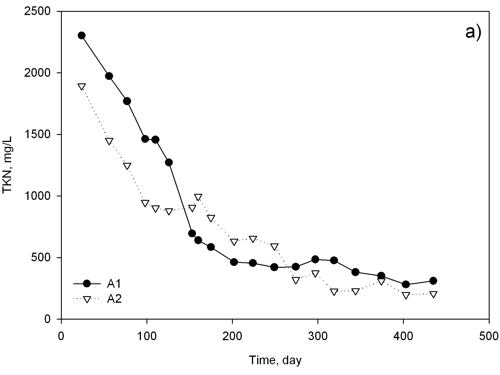 |
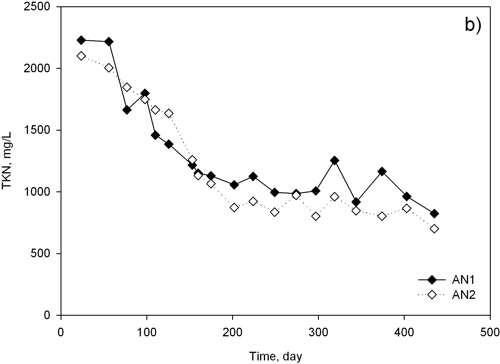 |
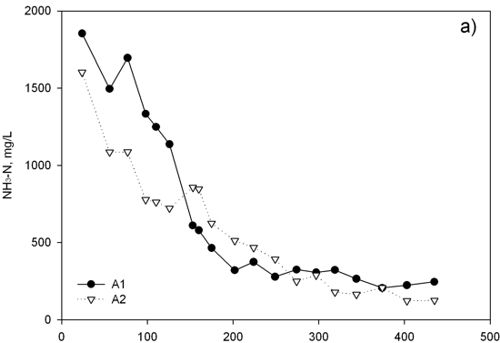 |
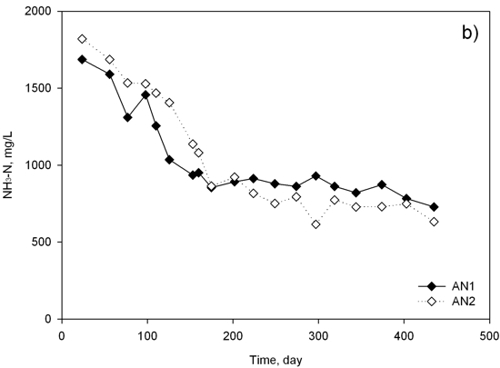 |
Figure 12. The change of TKN and NH3-N concentrations in aerobic (a) and anaerobic (b) test cells
The highest ammonia concentrations were measured to be 1850; 1600; 1700 and 1800 mg/L for A1, A2, AN1, and AN2 test cells, respectively. Ammonia concentrations were 245; 125; 730 and 630 mg/L for A1, A2, AN1 and AN2 test cells at the end of experiment. The presence of oxygen in aerobic test cells leads to nitrification so ammonia concentration is lower in these cells. Some researchers indicated that aeration itself does not solve the ammonia–nitrogen problem as the resultant increased waste temperatures may inhibit nitrification. However, the results of this study show that ammonia–nitrogen can be removed under conditions of both forced or natural aeration.
3.1.3. Organic content of leachate
Leachate from the acidic phase at sanitary landfills is characterized by high values of organic pollutants and a large portion of the organic matter consists of volatile acids. BOD and COD are the most widely used parameters of organic pollution applied to both wastewater and surface water. The determination of BOD and COD involves measuring dissolved oxygen in the biochemical oxidation of organic matter. BOD and COD vary with the age of the landfill. The BOD and COD in the leachate indicating the quantity of easily degradable organic compounds is expected to decrease by time in the biologcal decomposition processes.
The variations in the COD and BOD concentrations of aerobic and anaerobic test cells are given in Figure 13.
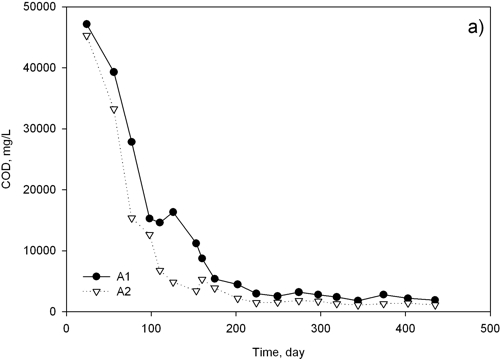 |
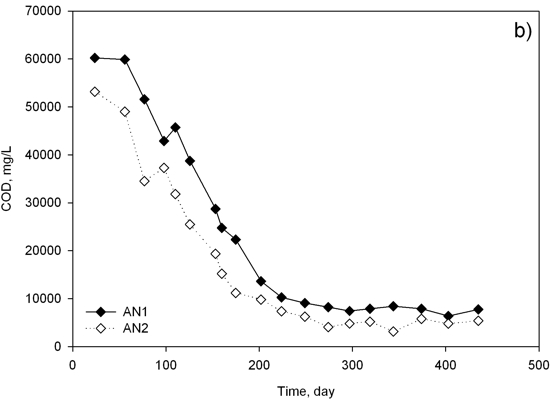 |
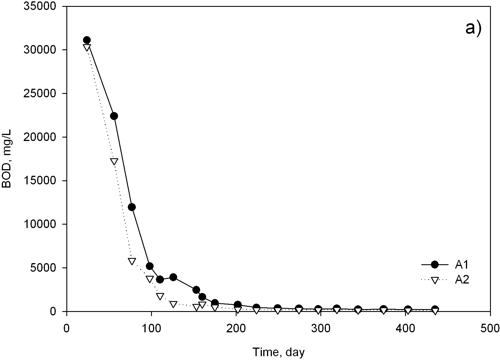 |
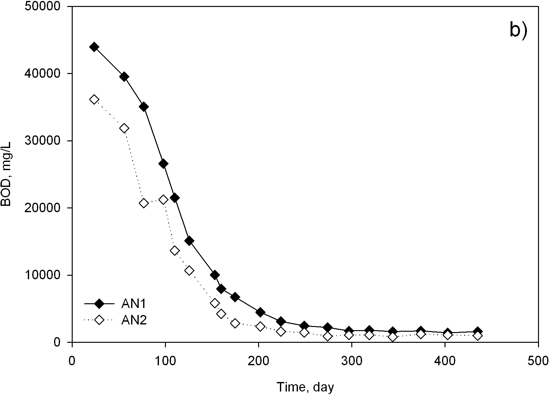 |
Figure 13. The change of COD and BOD concentration in aerobic (a) and anaerobic (b) test cells
As can be seen from Figure 13, the initial COD concentrations of aerobic test cells were determined around 45000 mg/L in the first 30 days of operation. COD concentrations decreased sharply to the values of 8700 and 3400 mg/L in A1 and A2 test cells, respectively on day 160. This suggests that the decomposition of the organic matter of MSW occurred in a relatively short period of time in aerobic test cells and for the remainder of the operation the COD values did not change significantly. Final COD concentrations of A1 and A2 test cells were determined to be 1900 and 1100 mg/L, respectively. As can be seen from Figure 13, the relatively rapid decrease in COD observed between the 10th and 100th day of the experiment corresponded to the thermophilic conditions. These results are similar to a previous investigation conducted by Jun et al. and Giannis et al. The similar phenomenon can be seen for COD concentrations in anaerobic test cells from Figure 13. At the beginning of the test period, COD values of leachate samples collected from AN1 and AN2 test cells were determined around 60000 mg/L for anaerobic test cells. High organic content of leachate in anaerobic test cells indicates that acidogenic conditions are dominant in waste degradation in which complex organic matter converts to soluble organic acids such as acetic, propionic and butyric acid. After 100 days of operation, with the methane production in the test cells COD concentrations began to decrease rapidly. COD concentrations of AN1 and AN2 test cells were determined to be 8000 and 5400 mg/L, respectively, at the end of the study.
The results of the BOD concentrations over time are shown in Figure 13. The BOD values of leachate samples were ranging initially from 30000 to 44000 mg/l in aerobic and anaerobic test cells. This represents the initial aerobic phase of biodegradation. After 200 days of operation, the BOD values decreased substantially to 750, 250, 4500 and 2300 mg/L in A1, A2, AN1 and AN2 test cells, respectively. The high BOD concentrations in the leachate samples collected from aerobic test cells only lasted for 100 days followed by a quick BOD decline. The experimental results indicated that the MSW stabilization was achieved in the aerated (forced or natural) test cells at a higher rate than that of the anaerobic test cells. Additionally, COD and BOD concentrations of AN1 test cell leachate samples are lower than AN2 test cell leachate samples. This can be explained by the effect of leachate recirculation on anaerobic degradation. Cossu et al. found that the COD values of the leachate from aerobic dry and wet reactors were lower than the anaerobic reactor in their column study. They found that after 120 days of operation the COD value of the anaerobic landfill reactor was approximately 20000 mg/L while this values were 3000 and 800 mg/L in the aerobic dry and wet reactors, respectively. The results of this study show similar results of the study made by Cossu et al. indicate that aeration and leachate recirculation has a positive effect on the solid waste degradation rates in aerobic landfills.
The ratio of COD value measured in aerobic and anaerobic test cells to maximum COD value determined in each cell is given in Figure 14.

Figure 14. The ratio of Total COD / Max. COD for aerobic and anaerobic test cells
As can be seen from Figure 14, degradation rate is maximum in A2 test cell. COD removal efficiencies obtained in A1, A2, AN1 and AN2 test cells were calculated as 90, 95, 77 and 82%, respectively. These results indicate that aeration accelerates waste degradation in landfills and improves leachate quality.
BOD/COD ratios of A1, A2, AN1 and AN2 test cells are shown in Figure 15.
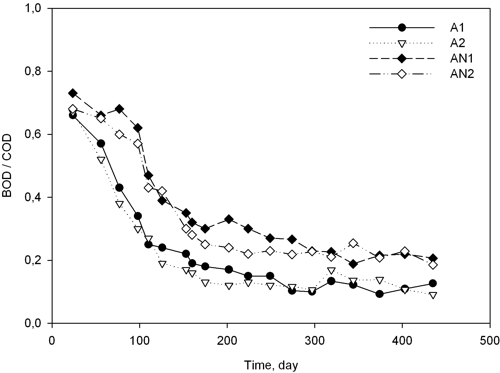 |
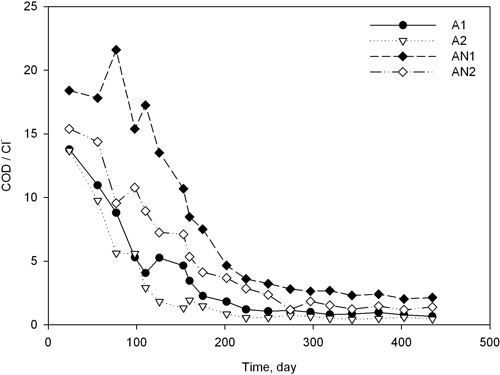 |
Figure 15. The BOD/COD and COD/Cl- ratios of aerobic and anaerobic test cells
At the beginning of the study, BOD/COD ratios were about 0.7 for aerobic and anaerobic test cells. A ratio of 0.4–0.8 implies a highly biodegradable leachate. Although the criteria vary due to several factors, there is a common thought that stabilized landfill leachate has a BOD/COD value of less than 0.1. Generally, the BOD5/COD of young leachate is greater than that derived from stabilization. The low BOD5/COD ratio indicates that the leachate is stable and difficult to be degraded further biologically.
BOD/COD ratio was determined to be 0.34, 0.30, 0.62 and 0.57 in A1, A2, AN1 and AN2 test cells after 100 days of operation. BOD/COD ratio of aerobic test cells decreased below 0.20 after 200 days of operation. At the end of the study, BOD/COD ratios of aerobic and anaerobic test cells were determined below 0.10 and 0.20, respectively. It can be concluded from these results that aerobic test cells had reached a stable state in a shorter time. Kjeldsen et al. in their review study reported the BOD/COD ratio in the acid phase leachate was above 0.7 and the BOD and COD values begin to decrease and the pH increases as acids are consumed. The BOD/COD ratio is around 0.1 in most cases in the stabilized landfill leachate. The BOD5/COD average ratios for the collected leachate samples were determined in the range of 0.10-0.70. Results ranged from 0.043 to 0.67 have been published by previous researchers and confirm the present ranges of BOD5/COD. The results of the study are in accordance with the literature data and it can be seen that leachate recirculation increases the degradation of the solid wastes in aerobic landfills slightly.
Additionally,
COD/Cl- ratio
of leachate collected from aerobic and anaerobic test cells is given in Figure 15.
The reduction in this parameter indicates that COD removal is the result of
biological activity. It can be seen from Figure 15 that the rate of biological
degradation in aerobic test cells is faster than that of anaerobic test cells.
3.2. Temperature Variations
Temperature probes were located at 1.0, 1.5, 2.0 and 3.0 m depths from the top of the waste to monitore temperature variation in each test cell. The average temperature values determined by the temperature probes in each test cell are depicted in Figure 16.
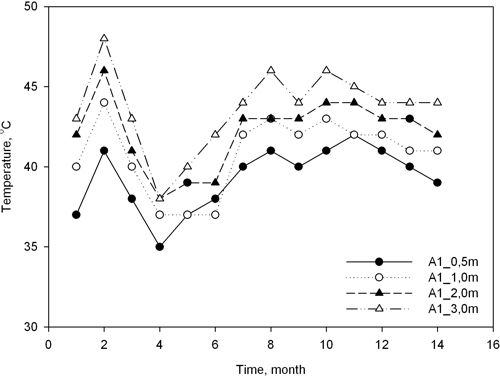 |
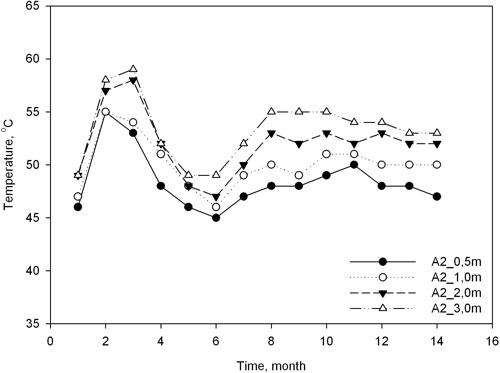 |
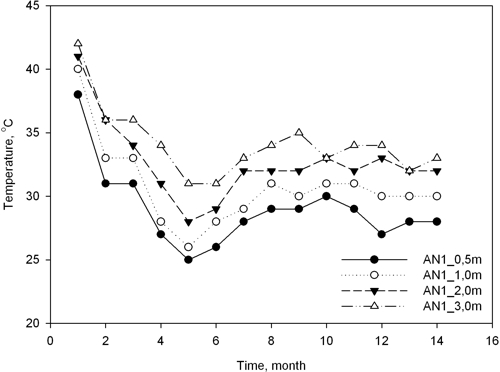 |
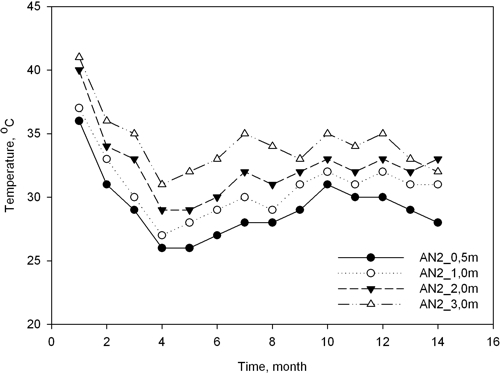 |
Figure 16. The variation of temperature in the landfill body
Because of the significant differences in energy balance of aerobic and anaerobic degradation processes, considerable differences in temperature variation in landfill body of aerobic and anaerobic test cells were also observed.
The temperature in the landfill body of semi-aerobic test cell (A1) was measured as 40 °C at the beginning of the study. After 2 months of operation, temperature reached to the maximum value of 48 °C. Because of the rainy and cold season, temperature began to decrease after that time but it was not observed below 35 °C till the end of the study. In the spring months it is determined that the temperature increased to the range of 40-45 °C and no considerable change was observed during the study.
The initial temperature determined in the aerobic test cell determined in the range of 45–50 °C. The temperaure of the landfill body increased and reached to its maximum values of 50-60 °C in A2 test cell. After the decrease in winter months, increase in temperatures measured in four different dephts was observed. The temperature measured in A2 test cell after cold months till the end of the study ranged between 45–55 °C.
The temperature variations in anaerobic test cells were determined in limited ranges. An increase in waste temperature in the landfill body was observed, during the initial aerobic phase. After the depletion of the present oxygen in the void spaces of the waste mass, temperature decreased around 30 °C. There was no significant change till the end of the study after that time.
3.3. Topographic Measurements
The rate of landfill settlement mainly depends on the waste composition, operational conditions and factors affecting biodegradation of landfill waste. All factors that accelerate the decomposition of biological processes (organic matter content, temperature, moisture content, pH, etc.), but also increases the rate of settlement. However, the amount of settlement may not be uniform in various regions of the landfill due to the effective decompositon processes. Most of the settlement of solid waste occures in the first few years after landfilling operation.
There were 14 points in each cell used for the topographic measurements. The first measurements were taken after the closing of the test cells. The second measurements were taken after 12 months of operation (data not shown). The amount of settlement in A1, A2, AN1, and AN2 test cells were determined to be 24.0, 32.6, 11.0 and 20.4 cm, respectively. It can be seen that settlement observed in A2 test cell is greater than that of the other test cells. Assuming that the mechanical settlement rates are equal to each other in all test cells, the difference in the settlement occured in A2 test cell can be explained by the eccelerated degradation of solid waste.
4. Conclusion
In this study, alternative landfilling methods for accelerating solid waste stabilization in landfills are investigated by the means of leahate quantity and quality, temperature variation and settlement amount in the landfill body.
From the general findings of this study, it can be concluded that:
-
Aeration in municipal solid waste landfills is a viable management option for the accelerated stabilization of a waste matrix. Aerobic test cells exhibit a higher rate of biodegradation, and achieve a high waste volume reduction in a relatively short duration than anaerobic test cells. The acceleration of MSW biodegradation not only decreases the life of the landfill, but also reduces overall monitoring costs incurred with post-closure of landfill sites.
-
Semi-aerobic landfilling technology is a viable method to be used in developing countries such as Turkey, based on the results of the cost benefit analysis of the entire implementation process, from the development stage to final closure.
-
The anaerobic landfill shows the highest levels of all pollutional parameters, with high concentrations. However; leachate recirculation to anaerobic landfills accelerates the rate of biological degradation of solid waste and improves leachate quality.
-
Aeration and leachate recirculation enhance the settlement of the solid waste landfilled and result in the recovery of landfill air space, which can be utilized for landfilling more solid waste.
Acknowledgements
This research has been supported by The Scientific and Technological Research Council of Turkey (TUBITAK - CAYDAG) (Project Number: 106Y228) Ankara-Turkey. The authors wish to acknowledge ISTAC (Istanbul Metropolitan Municipality Environment Protection and Waste Material Recycling Industry and Trade J.S.Co.) and Dr. Nedim Onur AYKUT (Yıldız Technical University) for his help in topographic measurements.
Mehmet Sinan Bilgili, Assoc. Prof., Dr, Faculty of Civil Engineering, Department of Environmental Engineering, Yildiz Technical University, 34220 Davutpasa, Esenler, Istanbul, Turkey. Tel. +90 (212) 383-53-70, fax +90 (212) 383-53-58. E-mail
Selin Top, Faculty of Civil Engineering, Department of Environmental Engineering, Yildiz Technical University, 34220 Davutpasa, Esenler, Istanbul, Turkey. E-mail
Elif Sekman, Faculty of Civil Engineering, Department of Environmental Engineering, Yildiz Technical University, 34220 Davutpasa, Esenler, Istanbul, Turkey. E-mail
Gamze Varank, Faculty of Civil Engineering, Department of Environmental Engineering, Yildiz Technical University, 34220 Davutpasa, Esenler, Istanbul, Turkey. E-mail
Ahmet Demir, Faculty of Civil Engineering, Department of Environmental Engineering, Yildiz Technical University, 34220 Davutpasa, Esenler, Istanbul, Turkey. E-mail
© Íåçàâèñèìîå àãåíòñòâî ýêîëîãè÷åñêîé èíôîðìàöèè
